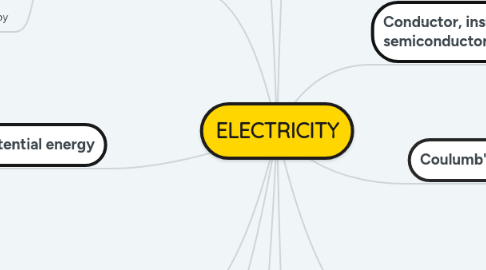
1. Electric Field
1.1. Exists in the space around the region of an electric charge that experiments an electric force.
1.1.1. it has
1.1.1.1. magnitude and direction
1.1.1.1.1. E= F/q
2. Electric current
2.1. Unit
2.1.1. Ampere (A)
2.1.1.1. An ampere is a flow of 1 Coulumb per second.
2.2. defined as
2.2.1. The amount of electrons that flow through a conductor.
2.3. represented by
2.3.1. I=q/t
3. Electric potential energy
3.1. The energy gained by the charge due to its position in the electric field
3.1.1. also
3.1.1.1. The potential energy (V) between point A and point B is the work necessary to displace a unit of positive test change (+q) from A to B.
3.1.2. The potencial energy of a charge at point B compared to point A is equal to the work done against the electric forces needed to displace the charge from A to B
3.2. its formula is
3.2.1. V= W/q
4. Electrical Power
4.1. How fast work is done or the energy consumed per second
4.1.1. measured in
4.1.1.1. Watts (W)
4.1.1.1.1. Watt's Law
5. Ohm's Law
5.1. The intensity of the current of a circuit is directly proportional to the potential difference (voltage) and inversely proportional to the resistance.
5.1.1. its equation is
5.1.1.1. I= V/R
5.1.1.1.1. Voltage (V)
6. Nuevo Tema
7. Electric Charge
7.1. Unit
7.1.1. Coulumb (C)
7.2. Neutron
7.2.1. Has a neutral charge
7.2.1.1. its value is
7.2.1.1.1. =0
7.3. Electron
7.3.1. Negative charge
7.3.1.1. its value is
7.3.1.1.1. -1.602x10^-19 C
7.4. Proton
7.4.1. Positive charge
7.4.1.1. its value is
7.4.1.1.1. +1.602x10^-19 C
7.5. Law of charges
7.5.1. like charges repel each other, unlike charges attract each other
7.6. it is represented with letter (q)
8. Conductor, insulator and semiconductor materials
8.1. Insulator
8.1.1. Material when an electric charge is placed, it will remain where it was placed
8.2. Conductor
8.2.1. Are those materials when electrons are added, they will distribute through the material.
9. Coulumb's Law
9.1. The magnitude of the electric force between two point charges is directly proportional to the product and inversely proportional to the square of their distance.
9.2. K
9.2.1. constant
9.2.1.1. K= 9x10^9 Nm^2/C^2
10. Electric Circuit
10.1. there are four
10.1.1. Simple
10.1.1.1. made of a source, resistance and wires.
10.1.2. Series
10.1.2.1. source with 2 or more resistors connected one after another.
10.1.3. Parallel
10.1.3.1. 2 or more resistors connected directly to a source.
10.1.4. Mixed
10.1.4.1. 2 or more resistance connected in series or more branches in parallel.
11. Electrical resistance
11.1. measured with
11.1.1. Ohmmeter
11.2. represented with letter (R)
11.2.1. opposition the conductors offer to electric current flow.
11.3. depends on the four factors
11.3.1. -nature of the substance (p) -temperature (t) -length of conductor (L) -area of the conductor (A)
11.3.1.1. represented with
11.3.1.1.1. R= p. L/A
